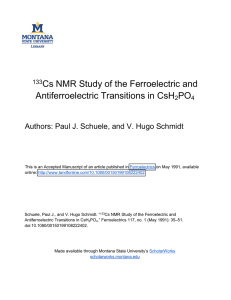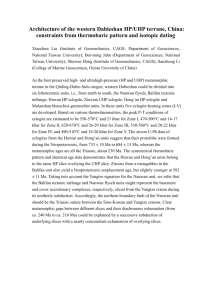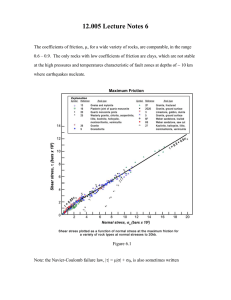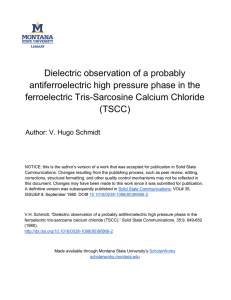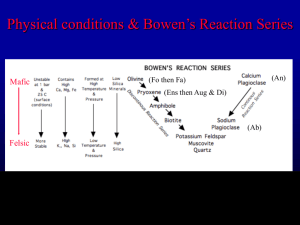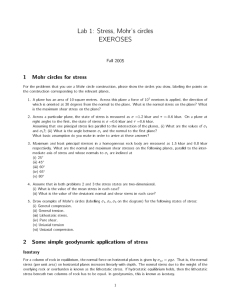Document 13553078
advertisement
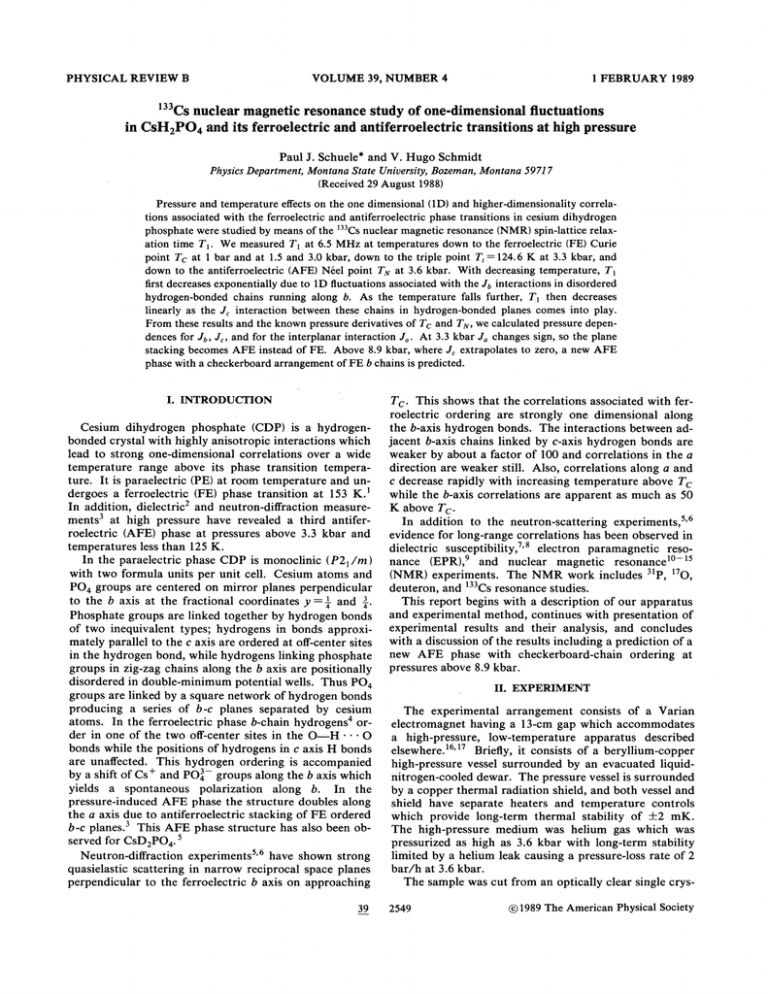
PHYSICAL REVIE%' B
VOLUME 39, NUMBER 4
1
FEBRUARY 1989
Cs nuclear magnetic resonance study of one-dimensional fluctuations
in CsH2PO4 and its ferroelectric and antiferroelectric transitions at high pressure
Paul
Physics Department,
J. Schuele*
and V. Hugo Schmidt
Montana State Uniuersity, Bozeman, Montana 5971 7
(Received 29 August 1988)
correlaPressure and temperature effects on the one dimensional (1D) and higher-dimensionality
tions associated with the ferroelectric and antiferroelectric phase transitions in cesium dihydrogen
Cs nuclear magnetic resonance (NMR) spin-lattice relaxphosphate were studied by means of the
ation time T, . We measured T& at 6.5 MHz at temperatures down to the ferroelectric (FE) Curie
point T& at 1 bar and at 1.5 and 3.0 kbar, down to the triple point T, =124.6 K at 3.3 kbar, and
down to the antiferroelectric (AFE) Neel point T& at 3.6 kbar. With decreasing temperature, T&
first decreases exponentially due to 1D fluctuations associated with the Jb interactions in disordered
hydrogen-bonded
chains running along b. As the temperature falls further, T& then decreases
linearly as the J, interaction between these chains in hydrogen-bonded
planes comes into play.
From these results and the known pressure derivatives of Tc and Tz, we calculated pressure dependences for Jb, J„and for the interplanar interaction J, . At 3.3 kbar J, changes sign, so the plane
stacking becomes AFE instead of FE. Above 8.9 kbar, where J, extrapolates to zero, a new AFE
phase with a checkerboard arrangement of FE b chains is predicted.
"
I.
INTRODUCTION
Cesium dihydrogen phosphate (CDP) is a hydrogenbonded crystal with highly anisotropic interactions which
lead to strong one-dimensional correlations over a wide
temperature range above its phase transition temperature. It is paraelectric (PE) at room temperature and undergoes a ferroelectric (FE) phase transition at l53 K. '
In addition, dielectric and neutron-diffraction
measurements at high pressure have revealed a third antiferroelectric (AFE) phase at pressures above 3.3 kbar and
temperatures less than 125 K.
In the paraelectric phase CDP is monoclinic (P2, /m)
with two formula units per unit cell. Cesium atoms and
PO4 groups are centered on mirror planes perpendicular
to the b axis at the fractional coordinates y = —
„' and
—,
Phosphate groups are linked together by hydrogen bonds
of two inequivalent types; hydrogens in bonds approximately parallel to the c axis are ordered at off-center sites
in the hydrogen bond, while hydrogens linking phosphate
groups in zig-zag chains along the b axis are positionally
disordered in double-minimum potential wells. Thus PO4
groups are linked by a square network of hydrogen bonds
producing a series of b-c planes separated by cesium
atoms. In the ferroelectric phase b-chain hydrogens order in one of the two off-center sites in the
H .
bonds while the positions of hydrogens in c axis H bonds
are unaffected. This hydrogen ordering is accompanied
by a shift of Cs+ and PO4 groups along the b axis which
yields a spontaneous
polarization
along b. In the
pressure-induced AFE phase the structure doubles along
the a axis due to antiferroelectric stacking of FE ordered
b-c planes. This AFE phase structure has also been observed for CsD2PO~.
Neutron-difFraction
experiments ' have shown strong
quasielastic scattering in narrow reciprocal space planes
perpendicular to the ferroelectric b axis on approaching
'.
0—
0
39
T&. This shows that the correlations associated with ferroelectric ordering are strongly one dimensional along
the b-axis hydrogen bonds. The interactions between adjacent b-axis chains linked by c-axis hydrogen bonds are
weaker by about a factor of 100 and correlations in the a
direction are weaker still. Also, correlations along a and
c decrease rapidly with increasing temperature above Tc
while the b-axis correlations are apparent as much as 50
K above T&.
In addition to the neutron-scattering
experiments, '
evidence for long-range correlations has been observed in
dielectric susceptibility, ' electron paramagnetic resonance (EPR), and nuclear magnetic resonance'
(NMR) experiments. The NMR work includes 'P, ' 0,
deuteron, and ' Cs resonance studies.
This report begins with a description of our apparatus
and experimental method, continues with presentation of
experimental results and their analysis, and concludes
with a discussion of the results including a prediction of a
new AFE phase with checkerboard-chain
ordering at
pressures above 8.9 kbar.
II. EXPERIMENT
The experimental arrangement consists of a Varian
electromagnet having a 13-cm gap which accommodates
a high-pressure, low-temperature
apparatus described
elsewhere. '
BrieAy, it consists of a beryllium-copper
high-pressure vessel surrounded by an evacuated liquidnitrogen-cooled dewar. The pressure vessel is surrounded
by a copper thermal radiation shield, and both vessel and
shield have separate heaters and temperature controls
which provide long-term thermal stability of +2 mK.
The high-pressure medium was helium gas which was
pressurized as high as 3.6 kbar with long-term stability
limited by a helium leak causing a pressure-loss rate of 2
bar/h at 3.6 kbar.
The sample was cut from an optically clear single crys-
'
2549
1989
The American Physical Society
2550
PAUL
J. SCHUELE
AND V. HUGO SCHMIDT
tal grown by slow evaporation from an aqueous solution
of Cs2CO3 and F205. It was mounted with the b axis
parallel to the applied static magnetic field Hp and the c
axis parallel to the NMR field H, . At this orientation
the quadrupolar
collapses, ' so the NMR
splitting
of
a
single Zeeman line with a wellresponse consists
defined spin-lattice relaxation time ( T, ).
The NMR spectrometer was operated at a fixed frequency of 6.5 MHz which corresponds to a field of 1.1639
T for ' Cs nuclei. To measure the spin-lattice relaxation
time T„ the spin system was first saturated by a comb of
90' pulses, and then after a waiting time ~ the response to
a 90 pulse was observed. The free induction decay after
at a
the pulse was digitized and the response amplitude
suitable delay after the end of the 40-psec dead time was
noted, and compared to the amplitude Ip for long ~. A
semilogarithmic
plot of Ip-I against ~ yielded straight
lines, indicating a single relaxation time T&.
Most of our T, measurements were made from 220 K
down to 2' or 3' above the ferroelectric or antiferroelectric transition temperature, which ranged from 153 K at
were
1 bar to 123 K at 3.6 kbar. These measurements
made at five hydrostatic pressures, namely 1 bar and 1.5,
3.0, 3.3, and 3.6 kbar. The paraelectric-ferroelectricantiferroelectric triple point occurs at 3.3 kbar and 124
K, approximately. Therefore, we were able to observe
the behavior when approaching both the ferroelectric and
antiferroelectric phases as well as when approaching the
triple point.
The relaxation rate ( T, ' ) versus temperature (T) results are presented in Fig. 1 for the above pressures. To
aid comparison, T, is plotted against T for all five pressures in Fig. 2. In general terms, at each pressure T, decreases with temperature in a similar way. At higher
temperatures the T, behavior corresponds nearly to that
expected for proton intrabond fluctuations in a strictly
1D Ising chain with FE coupling between protons. At
lower temperature, T& exhibits a Curie-Weiss form extrapolating to zero T, at the ordering temperature for the
2D-coupled hydrogen-bonded
planes. Detailed discussion of these phenomena and of the indirect evidence for
a narrow third temperature regime dominated by the
weak interplanar interaction is given in the following two
sections.
I
III. THEORY
The interpretation of these results is made within the
framework of a theory presented by Blinc, Lozar, Topic,
and Zumer (abbreviated here as BLTZ). ' In this theory
the strongest interaction, which is the FE coupling in the
ordering chains, is treated exactly. The intermediatebetween such chains within a
interaction
strength
hydrogen-bonded
plane, and the weakest interaction
which is between such planes, are treated in the meanWe correct some misprints in the
field approximation.
BLTZ equations.
Also, we extend their mean-field
analysis of the two weaker interactions, which they perwithout separating the effects of
formed numerically
these two interactions, to show that the intermediate interaction causes Curie-Weiss —type dependence of T, on
39
T —TC2D, while the weakest interaction gives a dependence varying as ( T —Tc ) ' ~ in a narrow temperature
range just above Tc.
The BLTZ theory has its roots in the wave-vectordependent susceptibility for the pure 1D Ising model
developed by Suzuki and Kubo, ' and the static behavior
including the phase transition for a system of weakly coupled 1D chains studied by Scalapino et al. ' Zumer
combined
those two approaches
to obtain the
dependent susceptibility for the weakly coupled system.
BLTZ introduced anisotropy into the interchain interactions and calculated quadrupolar spin-lattice relaxation
from
the
ac dielectric
susceptibility
the
using
fluctuation-dissipation
theorem. In each case, the intrachain interactions were treated exactly and the interchain
interactions in the mean-field approximation.
The BLTZ theory begins with the assumption that the
dominant mechanism for spin-lattice relaxation is the interaction of the nuclear electric quadrupole moment with
the fiuctuating electric field gradient (efg). This assumption appears to be correct over the temperature ranges
covered in our experiments. It is further assumed that
the quadrupolar interaction is small compared to the Zeeman interaction of the nuclear magnetic dipole moment
with the applied magnetic field Hp Under these assumptions the inverse spin-lattice relaxation time I /T, for
'for
(I= —
quadrupolar relaxation of nuclei having spin
,
Cs) and quadrupole moment Q is given by
I
4
40k'
2
I (2I —1)
[J"'(co)+4J' '(2')],
in which the spectral density of the autocorrelation function for the fluctuating efg tensor at the ' Cs site is
J'"'(co) =
J
( V'"'(0)V' "'(t) )exp(ikcot)dt .
Here the following notation is used in terms of efg components for a system with the z axis along the applied
magnetic field Hp..
v'+"=v xz +iv
— yz
In Eqs. (1) and (2), the average efg components contribute
nothing to the relaxation, so in Eq. (3) we need only the
of the fluctuations about these averages.
magnitudes
These fluctuations result mostly from atomic displacements within a "source radius" of perhaps 5 A around
the Cs nucleus, caused by proton motions in the disordered chains. Each Cs nucleus is within 5 A of two disordered H-bonded chains belonging to the same H-bonded
plane. We assume that the fluctuation correlation length
is greater than the source radius, so the efg at a given Cs
nucleus at a given instant approximates its static value inside a FE domain. (From the neutron-scattering
study of
Frazer et al. , ' this assumption is good over a wide temperature range for the intrachain b correlations, and from
their Fig. 6 may be good for 5 or 10 K above Tc for the c
correlations between chains in the same H-bonded plane. )
Accordingly, we choose for the magnitude of the fluctuations half of the difference between the two efg's deter-
39
Cs NUCLEAR MAGNETIC RESONANCE STUDY OF ONE-DIMENSIONAL.
mined by Kanda and Fujimara' for the two FE domains
in the FE phase. This assumption differs somewhat from
that of BLTZ, who used the difference between the efg
for one FE domain type and the efg for the PE phase.
In the BLTZ development, Eq. (2) is then Fourier
transformed, the random phase approximation is made,
and the shortness of the efg source radius is invoked so
that
Vo", which leads to
1
j(~)= —
g j,. (~)=
60~ ~
i
(
V
Vyy )
Tc=
+1
~ l~~Cs
6, 5 MHz
8.8 MHz
I
~
I
I
Cs
I
(
gy"(~, q)
.
Here C is the Curie-Weiss constant for the dielectric behavior, X is the number of mobile protons, q is the wave
vector, and a factor of 2 missing in BLTZ is inserted.
The BLTZ analysis for the susceptibility follows that of
(4)
'+ V y ]j(2')
2T
q
J'"(co) =( V, + V, )j(co),
~&
2551
Here j(co) is a sum over Fourier components, which following Topic et al. ' is related to the imaginary part of
the pseudo-one-dimensional
Ising model wave-numberdependent susceptibility,
V"=
J'2'(2'): [
..
Tc
OO—
= 1%0.5
K
~
B LT Z)
Cs at 6.5 MHz
I
p =
I
I
I
EQ
40-'
CD
I
OP
I
CD
I
p
~
I
!
(b)
0
o
C)
20-I
40
20—
I
~
I
I
I
I
I
Q,
200
Temperature
l40
l20-
T c=
t27
300
250
~
~
~—
80
I90
—~
200
(K)
Cs at
I
40
0
I
=l24K
I
p
=
65 MHz
5. 5
kbar
I
I
120
IOO-
(c)
I
I
0
I
~-~ —
~
160
I
0
I
I
I
~~~~—
I
~
I
y
I
~
Q
I
140
(cI)
I
80604020-
O
I
120
I
——
l70
CD
I
I
l60
I
I
2,
0
~
I
l50
Tq
I
l80l60-
Cs at 6.5 MHz
p = 5, 0 kbar
C)
40C)
0-
l40
200
I
60-
~ «e~~
I
Temperature
I
80-
Ii
(K)
K
I
IOO—
tD
I
0
I
150
l. 5 kbar
I
(a)
I—
=
I
60—
I
o
0
80—
bar
1
220
200
I80
Temperature
40
I
TN
~~
f00-
i)~
l25
220
(K)
K
65
Cs at
~
p
=
MHz
5.6 kbar
I
ao-'
o
D
—"
200
I80
Temperature
I20CP
I60
l40
(K)
I
o
I20
60
40-
,
II
I
~.
(e)
~
o,
I
20-
I
I
~
I
0
I
l20
I
40
«~ ~~~—
~
I
60
~
Temperature
1
~
~
200
IBO
2.20
(K)
FIG. 1. Critical component of the spin-lattice relaxation rate for ' Cs in CsH2PO~ as a function of temperature,
bar, (b) 1.5 kbar, (c) 3.0 kbar, (d) 3.3 kbar, and (e) 3.6 kbar.
at pressures of (a)
2552
PAUL
J. SCHUELE
AND V. HUGO SCHMIDT
Upon integrating over z and neglecting coco which is
small for the frequency used in the temperature range
studied, we obtain
300
j
200
Tl
=
cij
2
l30
l50
l
70
l
90
dependence of the critical portion of
'Cs spin-lattice relaxation time T& in CsH&PO4 for pressures of
1 bar, circles (BLTZ data shown
1.5 kbar
by diamonds),
(squares), 3 kbar (triangles), 3.3 kbar (stars), and 3.6 kbar (pentagons). Predictions of Eqs. (18) and (27) are indicated by solid
lines. Dashed line portions correspond to an extrapolation of
the 2D expression of Eq. (21). The line for 3.3 kbar is omitted
for clarity.
using the fact that
becomes
Zumer,
ignoring tunneling which seems to have no major e6'ect, treating intrachain interactions exactly via the
one-dimensional
Ising model, and treating the much
weaker interchain interactions in the mean field. The
Hamiltonian for the jth chain with z (z =4 for CDP) adjacent chains then is
+ X ~p, m ~Pr j + m
m=1
~Pr
j''
where Jb is the J~~ interaction for nearest proton neighbors in the disordered chains running along b,
is the J~
interaction which is (J,
)/2 (nearly J, /2 because
J, ), ' and the p's are pseudospins +1 representing
disordered proton positions.
From the susceptibility expression developed by BLTZ
they obtain two expressions for j(co) in their Eq. (26).
The first is correct but the second should be
J
+J,
J, «
roF siny
o
o
dx dg dz
[D(x,y) Ecosz] +(coro—
)
I,
F(1+a) '—
(cosx+a cosy )
= 1 —b ( cosx + a cosy ),
D(x, y) = 1 z'PJ
and y is the monoclinic angle of 72. 3
.
(12)
o
T
) Tc. Then j(co)
dx dp
m
~
(2 —
a) sn
all
(13)
o
[a —b(cosx+a
cosy)]
Integration over x yields
4
rr 2 (2
—a) 3/2
b —
ba—
cosy) ]
c—
cosy)'~
ba—
osy)(a +b ba —
I [2b /(a
X
(a
b
(15)
I
Here
represents a complete elliptic integral of the
second kind. Both in the argument of and in another
I
factor,
(a
+b
ba cosy) =—
(a +b),
so the expression for
j (co) can be simplified
4fI[2b/(a+b)]
~~(2 —
a) ~~(a+b)'
~
o
to
dy
a
b
bacosy—
—
(17)
The final integration over y produces the expression
a)
(2 —
~
4fI[2b/(a +b)]
a
[(a +b)(a b+ba)(—
b
)]'~—
ba—
(18)
(7)
where D, E,
and y are defined below. We also define
three new variables a, b, and f, which are more convenient for the following integrations:
a= Ja/Jc +(1
E =tanh(2PJb ) = 1 —a, a = 1 —tanh(2PJb ),
F = 2 exp( —2PJb ), f = roF sing,
P= 1 /kT, T ) Tc,
),
(14)
m.
7T
o
(2 —
a) ))b for
2f
m. z
V'
JbPl+1jPi j
b(co—
sx+a cosy
D(x, y)+E =2 —a —b(cosx+a cosy ) =2 —a,
2lo
FIG. 2. Temperature
7T3
«1
E]
D(x, y) E=—a
2
D(xy)dx dy
[D (x, y) E—
]~
)
l00
j(co) =
J~
The D (x, y) factor can be set to unity because b
for
—
all T Tc. The expression [D (x, y)
can be broken
into two subfactors,
{sec)
'
~
.
slI1
r
(8)
(10)
This expression is valid over the entire temperature range
above T~ within the approximations
listed above. We
now examine its predictions in four temperature regimes
above T&. These are the noncritical regime above room
temperature, the 1D regime below room temperature but
well above Tc, the 2D region extending to within a few
degrees of Tz, and the 3D region in the last degree or two
above T&. We note that Morosov and Sigov discussed
the importance of the 1D, 2D, and 3D correlation regions for CsHzP04 also, but in connection with dielectric
permit tivity.
In the noncritical regime the temperature is too high to
allow correlations even of the protons in H-bonded
chains running along b. In this regime, 1))(1—
a)))b
&)ab, the argument of approaches 0 so approaches
w/2, and Eq. (18) becomes
I
I
Cs NUCLEAR MAGNETIC RESONANCE STUDY OF ONE-DIMENSIONAL.
39
j(a7)h
»
r
4rpsiny
.
J
Here kT
J„&) &)J„and there is no significant temperature dependence predicted for j(co) or for the spinlattice relaxation rate T, .
)&b &)ab, which
In the 1D regime we have
1»a
yields
j(co) iD
3~2
(2a )3/2
2
rpsiny exp(4pJi,
)
.
(20)
Physically this means that relaxation is governed by the
Boltzmann factor for populations of (HPO4, H3PO4) defect pairs. The effective diffusion of these defects by
means of b-chain proton intrabond transfer causes the relaxation. As the temperature drops, the correlation time
becomes longer because the defect population drops, and
in the rapid-motion regime this increases the relaxation
rate which is proportional to j(co). The relaxation rate
according to Eq. (20) would become infinite at absolute
zero (the ordering temperature for the 1D Ising model), if
Eq. (20) were valid down to that temperature.
order becomes
In the 2D regime the inequality
b)))ab—
itself,
, so the argument of I, and
approach 1 because a +b =2b. Then j(co) becomes
I
1))a ))(a
I (ai)2D
nb
(a
b)—
(21)
fact—
critical behavior is in the (a b)
or
be expanded to give the temperature depen—TC2D) '. The Curie-Weiss temperature Tc2D
regime is found from the implicit relation
/kTC2D
—in[z'J»
/( I +a)kTc2D] .
(22)
This regime is recognized in the data by a straight portion of the T, versus T plot.
Before the temperature drops to T& zz the system goes
over into the 3D regime characterized
a
by 1
Then in add—ition to the
))(a b+a—
b)))(a b ab). —
approximations made in the 2D regime, we can also set
a—
b +nb =2ab, and we obtain
))
j(a~) =
mb
[2a (a
ab
b
)]'— —
(23)
',
The last factor when expanded gives critical temperature
where Tc is the actual transidependence (T —Tc)
tion temperature which is slightly above T&2~ and is
given by the implicit relation
2', /kTC = —ln(z'J
/kTC
)
.
(24)
Because much of our T, data is in crossover regions
between the above regimes, we use the general expression
in Eq. (17) for j(co). Since we are in the fast-motion regime, j(co) actually has no dependence on frequency co, so
=j(pi) in Eq. (4). Then the spectral density factor
in Eq. (1) becomes
j(2')
[J"'(co)+4J' '(2')]
=[V, + V, +(V„—V
)
+4V„]j(co) .
(25)
According to Kanda and Fujimura, ' the only efg tensor
2553
components at the ' Cs site which change upon domain
reversal in the FE phase of CDP are
eg V, .» /h
,
egV». /h
= eg V», /h =+7. 6 kHz,
(26)
=egV, /h =+12.5 kHz,
where the primed coordinates represent crystal axes and
the unprimed coordinates represent laboratory system
axes for our measurements in which the static magnetic
field Hp was along z, corresponding to the crystal y' or b
axis.
From the discussion following Eq. (3), the above numbers divided by eg /h are squared to provide V2, and V,
in Eq. (25), and the other V, . in that equation vanish.
'
Then, using = ', for —
Cs, Eq. (1) becomes
I
1/T, =2. 87X 10 s
(27)
j(co) .
Although we do not use Eqs. (28) —(33) of BLTZ, it is
helpful for anyone using that approach to note the following corrections. In Eq. (29), C should be D. In Eqs.
(30a) and (30b), B should be E. In Eq. (31), Q should be
Q, fi should be h, A p" and A p ' should be squared, and
the 2 p ' factor should be multiplied by 4. Equation (33)
should contain the factor 4siny/147 found in Eq. (31).
The expression appearing in Eq. (33) was mistakenly di—
", and the siny factor was omitted.
vided by
I=
where the
which can
dence (T
for this 2D
2Jh
..
IV. DATA ANALYSIS
There are four fitting parameters which could be used
predictions of Eqs. (18) and (27) to Ti results. These are the inverse attempt frequency 7 p which
is assumed independent of temperature and pressure, and
the three interaction energies J„Jb, and J, which are assumed to have linear dependence on hydrostatic pressure
but to be independent of temperature. The fitting process
requires
Eq. (27) for 1/T, , Eq. (18) for
( ai ),
the definitions
in Eqs. (8) —(10), and the relation
J» = ( J, + J, ) /2.
Unfortunately we did not obtain T, data close enough
to Tc to observe the 3D regime where T] is proportional
to (T —Tc)'~ . Only in this regime would the relaxation
results be sensitive to a or equivalently to J, . Accordingly, we use only the ~p, Jb, and J, parameters to fit the Ti
data. To find J, and its pressure dependence, we use the
which relies on the
method of Blinc and Sa Barreto
slopes dTcldp of transition temperature versus pressure
both above and below the triple-point pressure. Our
method differs from theirs only in that we use the pressure dependences of both Jb and J, determined from the
T, fit, whereas they implicitly assume no pressure dependence for J, .
The fit of T, for the parameters and their pressure
dependences given below is shown in Fig. 2. The straight
2D regime and curved 1D regime portions of the curves
are clearly seen.
The parameters and their pressure dependences found
from the T, fit and from the Tc versus pressure curve are
in comparing
j
PAUL
2554
J. SCHUELE
AND V. HUGO SCHMIDT
0-0-0-0
0-0-0-0
0-0-0-0
'0 0 0 0
~0=2. 9 X 10 ' sec,
Jb/k
J, /k
J, /k
=225. 7 K —(6. 85 K/kbar)p,
= 3. 80 K —(0.428 K /kbar )p,
=0. 305 K —(0.0924 K/kbar)p .
From the above fundamental parameters, several derived parameters are calculated and presented below to
allow comparison with values of these parameters used
by other authors,
J /k =2.05 K —(0. 520 K/kbar)p,
Jt, / J~ = 110,
39
J, /J, = 12. 5,
PE Phase
0= Pop~
~ ~ ~
H- bonded sheet
= unit cell
~
o
~
e
0
~
~
~
~
~
~
~
~
~
e
~
~
~
~
~
~
~
~
~
~
~
~
~
~
a
~
Tc=153.9 K, Tc20 150.9K,
at
1
bar .
are compared in Table I with some Jb,
and ~o values obtained by other workers.
The triple point at which the transition changes from
FE to AFE occurs at 3.30 kbar and 124.6 K from the
above parameters. At this point J, becomes negative, so
that the ferroelectrically ordered hydrogen-bonded planes
have AFE instead of FE stacking, yielding overall AFE
order.
Although we did not make any T, measurements in
the 3D region above T&, we did look at the NMR spectrum at 152.4 K and atmospheric pressure. This temperature is between the actual T& and T~2D which is the
temperature at which the 2D regime T, extrapolates to 0.
The NMR spectrum was characteristic of the FE rather
than the PE phase, indicating indirectly the presence of
the 3D regime with its square-root dependence of T& on
temperature.
'
FE
PE
These parameters
J,
~
~
~
~
~
~
~
~
8 0
AFEI
(3)
AFE I?
FIG. 3. Ordering of hydrogen bonds in CsH2PO4 in paraelec
tric (PE) phase, ferroelectric (FE) phase, antiferroelectric (AFE
I) phase composed of two oppositely polarized planar sublattices, and the postulated antiferroelectric (AFE II) phase composed of two oppositely polarized checkerboard sublattices.
Known and postulated
are shown also.
(for AFE
II
phase) unit-cell boundaries
schemes for the various
The chain-alignment
known and proposed phases appear in Fig. 3. So far, the
existence of this second triple point has not been investigated experimentally.
The phase diagram predicted by this linear pressuredependence assumption appears in Fig. 4. The pressure
dependence of T~ is predicted to change sign at this
higher triple point, so it should be possible to observe it
easily by dielectric means. This figure ends below the
pattern.
V. DISCUSSION
From the above parameters and their pressure dependences, we can predict that if the linear pressuredependence approximation holds, there will be another
triple point at 8.88 kbar and 76.7 K, where J, should go
to 0. Above this pressure, both J, and J, would be negative, so that looking along the b axis the chains would order in a checkerboard AFE pattern rather than a sheet
TABLE I. Energy parameters and correlation time from various experiments and theories, for
CsH2PO4 at atmospheric pressure. Note that some entries differ by factors of 2 or 4 from those appearing in the corresponding references because of differences in definitions of Jb and JP.
Jb/k (K)
Jp/k (K)
~0 (sec)
225.7
234
Jb /Jp = 100
305
250
287
273
265.5
2.05
3.39
2.9X10-"
1.9X 10
1.9X 10
1.8
1.9
3.0
3.0
5.7X 10
6.7X 10
300
278
3
2. 1
Method
Ref. no.
Cs NMR
Dielectric
'P chem. shift
Dielectric
Thermal expansion
Calorimetic
Hyper-Raman spec.
dc dielectric
ac dielectric
Dielectric
Calorimetric
This work
8
10
7
27
28
29
30
31
32
33
'"Cs NUCLEAR MAGNETIC RESONANCE STUDY OF ONE-DIMENSIONAL. . .
39
l50
ED
l00
T(K)
50—
l
I
p (k
20
l5
l0
bar)
FIG. 4. Known
and proposed phase diagram for CsH&PO4 at
low temperature and moderate hydrostatic pressure, showing
monoclinic space groups and number Z of molecules per unit
cell. Known phase boundaries are solid lines, proposed boundaries are dashed lines. Phases shown are paraelectric (PE), ferroelectric (FE), planar antiferroelectric (AFE I), and proposed
checkerboard antiferroelectric
perionic conductivity.
Finally, Baranowski et al. reported a transition at 1 bar and 380+1.5 K, in contradiction to the report by Rapaport et al. that the PE phase is
stable at 1 bar up to 422 K.
We do not attempt a critical evaluation of the various
parameters presented in Table I. We simply note that
are near the ranges found
our 1-bar values for J& and
'
Also, the ratio J, /J, =12.5
by other workers. '
at 1 bar is near the value of 10 found by BLTZ. Our
large value for ro is troublesome. Perhaps the efg Auctuations are considerably larger than those occurring when a
ferroelectric domain reverses, in which case a smaller and
more reasonable value of ~o would give the correct T&
magnitudes.
In conclusion, our results are in good accord with the
BLTZ theory, and provide a more complete test of that
theory than was possible based on the limited atmospheric pressure data of that paper. We have extended the
BLTZ theory to show the specific behaviors associated
with the 1D, 2D, and 3D fluctuation regions. Based on
these results a second triple point where the PE phase
meets both planar and checkerboard AFE phases is predicted. We hope that someone will undertake an experimental search for this triple point.
'
P2( or
P2I /0
(AFE II).
pressure of 32.9 kbar where the linear extrapolation of Jb
goes to 0, because that is too long an extrapolation to be
taken seriously.
Additional phase information appears in the work of
who presented a highRapaport, Clark, and Richter,
pressure phase diagram extending to 45 kbar but only
down to 0 C. They show an ill-defined boundary between the PE phase (their phase III) and their phase V,
which begins at 11 kbar and 150'C and which extrapolates approximately to our PE-AFE II phase boundary at
the 70 K, 20 kbar point. One possibility is that in their
phase V the c-axis hydrogen bonds also become disordered. Their phase I, which occurs above 503 K at 1 bar,
to exhibit suwas recently shown by Baranov et al.
*Present address: Rarntron Corporation, 1873 Austin Bluffs
Parkway, Colorado Springs, Colorado 80918
A. Levstik, R. Blinc, P. Kadaba, S. Cizikov, I. Levstik, and C.
Fihpic, Solid State Commun. 16, 1339 (1975).
N. Yasuda, M. Okamoto, H. Shimizu, S. Fujimoto, K. Yoshino, and Y. Inuishi, Phys. Rev. Lett. 41, 1311 (1978).
P. J. Schuele and R. Thomas, Jpn. J. Appl. Phys. 24, Suppl. .
24-2, 935 (1985).
4Y. Iwata, N. Koyano, and I. Shibuya, J. Phys. Soc. Jpn. 49, 304
~
(1980).
5R. Youngblood, B. C. Frazer, J. Eckert, and G. Shirane, Phys.
Rev. B 22, 228 (1980).
D. Semmingsen, W. D. Ellenson, B. C. Frazer, and G. Shirane,
Phys. Rev. Lett. 38, 1299 (1977)
R. Blinc, B. Zeks, A. Levstik, C. Filipic, J. Slak, M. Burgar, I.
Zupancic, L. A. Shuvalov, and A. I. Baranov, Phys. Rev.
Lett. 43, 231 (1979).
E. Kanda, A. Tamaki, and T. Fujimara, J. Phys. C 15, 3401
(1982).
S. Waplak, V. H. Schmidt, and J. E. Drumheller, Phys. Rev. B
34, 6532 (1986).
oR. Blinc, I. Zupancic, G. Lahajnar, J. Slak, V. Rutar, M. Ver~
2555
J
ACKNOWLEDGMENTS
We thank J. T. Wang for his careful growth
of CsHzPO4 crystals, and S. Zumer, B. Topic, and R.
Blinc for helpful discussions concerning their theory.
The hospitality of personnel at the Joief Stefan Institute
(Ljubljana, Yugoslavia) and support from the Fulbright
Foundation during the time that the results were being
analyzed, are acknowledged by one of us (V. H. S.). This
work was supported in part by National Science Foundation Grant Nos. DMR-8205280 and DMR-8714487.
bec, and S. Zumer, J. Chem. Phys. 72, 3626 (1980).
V. Zagar, and R. Blinc, J. Chem. Phys. 81, 3247
(1984).
B. Topic, V. Rutar, J. Slak, M. I. Burgar, S. Zurner, and R.
Blinc, Phys. Rev. B 21, 2695 (1980).
3R. Blinc, M. Mali, J. Slak, J. Stepisnik, and S. Zumer, J.
Chem. Phys. 56, 3566 (1972).
E. Kanda and T. Fujimara, J. Phys. Soc. Jpn. 43, 1813 (1977).
R. Blinc, B. Lozar, B. Topic, and S. Zumer, J. Phys. C 16,
5053 (1983).
' P. J. Schuele, Ph. D. thesis, Montana State University, 1988,
J. Seliger,
University Microfilm 88-11056.
P. J. Schuele and V. H. Schmidt, Rev. Sci. Instrum. 31, 1724
(1982).
M. Suzuki and R. Kubo,
J. Phys. Soc. Jpn.
24, 51 (1968).
D. J. Scalapino, Y. Imry, and P. Pincus, Phys. Rev. B 1, 2042
(1975).
S. Zumer, Phys. Rev. B 21, 1298 (1980).
B. C. Frazer, D. Semmingsen, W. D. Ellenson, and G.
Shirane, Phys. Rev. B 20, 2745 (1979).
A. I. Morosov and A. S. Sigov, Ferroelectrics Lett. 2, 105
(1984).
2556
R. Blinc and
~4E. Rapaport,
PAUL
J. SCHUELE
AND V. HUGO SCHMIDT
F. C. Sa Barreto, J. Chem. Phys. 72, 6031 (1980).
J. B. Clark, and P. W. Richter, J. Solid State
Chem. 24, 423 (1978).
A. I. Baranov, V. P. Khiznichenko, V. A. Sandier, and L. A.
Shuvalov, Ferroelectrics 81, 183 (1988).
B. Baranowski, M. Friesel, and A. Lunden, Z. Naturforsch.
4ia, 981 (1986).
E. Nakamura, K. Abe, and K. Deguchi, J. Phys. Soc. Jpn. 53,
1614 (1984).
~K. Imai, J. Phys. Soc. Jpn. 52, 3960 (1983).
S. Shin, A. Ishida, T. Yamakami, T. Fujimura, and M. Ishigame, Phys. Rev. B 35, 4455 (1987).
K. Deguchi, E. Okaue, and E. Nakamura, J. Phys. Soc. Jpn.
51, 3569 (1982).
~~K. Deguchi, E. Nakamura, E. Okaue, and N. Aramaki, J.
Phys. Soc. Jpn. 51, 3575 (1982).
S. Watarai and T. Matsubara, Prog. Theor. Phys. 71, 840
(1984).
E. Kanda, M. Yoshizawa, T. Yamakami, and T. Fujimura, J.
Phys. C i5, 6823 (1982).
